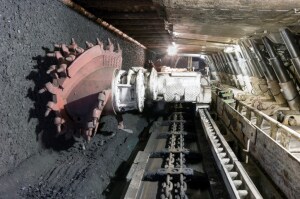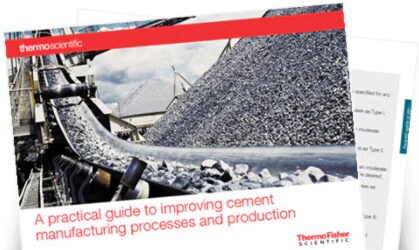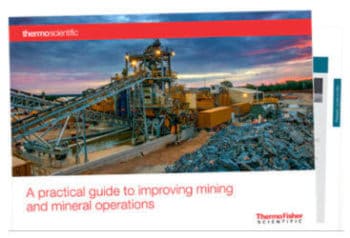My last post talked about the challenges of dust in a coal mine that my colleagues and I faced during a customer visit to a ‘room and pillar’ mining operation. This post will recap the events at our visit to a longwall mining operation.
Unlike the coal mine visit, where we had to crawl in the mud to get to the working face, this trek was much easier on the body. We traveled 600 feet down via a large elevator and were able to ride fully upright the half mile trip into the working face of the mine.
The longwall mining technique involves using a continuous miner to create two tunnels, in which conveyor belts are installed and also provides conduit for the inbound and outbound ventilation. Once the initial two tunnels are complete (in this particular mine, they were 1/4 mile apart), the continuous miner cuts a corridor between the two and the longwall miner is brought into the mine in sections and assembled underground.
The longwall miner can range from 40-70 feet long and has movable two rotating drums with tungsten steel augur bits. The head end makes the low cut (2-5 feet high, depending on the height of the coal seam) and the tail end completes the high cut (also 2-5 feet high). The coal falls unto a conveyor belt and is transported to the conveyor system in the parallel shafts for its trip to the surface. This type of mining can make a 1/4 mile long cut (about 3-4 feet wide) in under one hour and can provide 4-10 times the amount of coal as a continuous miner.
Rather than bolting supports into the roof, in this type of mining the roof is not supported. The miners stand beneath a series of heavy duty hydraulic roof shields, which supports the unsecured roof of the mine in the area of the longwall miner. As the longwall miner travels along the coal seam, it moves 3-4 feet forward and the roof shields pull forward as well to support the newly exposed roof. The roof collapses in the area vacated by the roof shields (providing a constant reminder of the danger).
Upon entering the mine we found that the longwall miner was down for repairs. A mechanic was welding new bits to the rotating drums and we had the chance to talk to the 10-12 miners in relatively quiet conditions.
Many of these were suspicious of the personal dust monitors we were wearing (and of us!), and expressed concern about carrying the extra weight as well as not knowing the real benefits. However, two miners (both were in their twenties) expressed an interest in finding out how it would help protect them and they continuously asked about the dust concentrations at various operations. After 40 minutes or so, they restarted the miner and began a cut.
The amount of dust was similar to the levels seen at our previous destination, but the amount of coal being cut was much greater. A large section of rock (estimated to weigh 500 pounds) fell from the roof and struck the longwall miner, resulting in the need to move it off to prevent damage to the equipment and possible injury to the miners (or their valued guests!).
Not wanting to risk injury, our host suggested we all leave.
This trip only confirmed what we learned from the ‘room and pillar’ mining operation: Coal mining is truly a dangerous job, from both long term effects and day to day dangers. Personal dust monitors may not be able to help prevent falling chunks of rock, but they can be used as a valuable engineering tool to quickly assess the impact of changes in engineering controls. Using the shortened average period, the effectiveness of these ventilation changes can be quickly evaluated. This is critical to overall dust control as the equipment is repositioned and a tremendous benefit in increasing the awareness of the dust exposure levels, hopefully leading to a reduction in Black Lung Disease.
Editor’s Note: Explore our Cement, Coal and Minerals Learning Center to access posters, webinars, white papers, applications notes and other resources regarding mining, from exploration through processing.







Now if we can get the companies to actually use these PDM’s as a tool! Also train the operators on how to use them!
Thank you for your comment, Ronald. Current rule making (RIN 1219-AB64) does call for specific use of the unit by selected occupations and has been awaiting final MSHA
approval for over a year. Also, each PDM3600 comes with a DVD containing
three videos on proper use, daily and quarterly preventative maintenance
actions. Let us know if you need another copy of the DVD.
Best regards,
Alan
Outside of the MSHA certification for intrinsic safety (which is a big difference), how does this personal dust monitor differ from other personal dust monitors like the the TSI SIDEPAK? What type of particle size selector does this monitor use to ensure only the respirable fraction of the dust is measured?
Thank you for your comment, William.
The PDM3600 Personal Dust Monitor differs by providing real time mass measurement through use of a TEOM (tapered element oscillating microbalance). This technology provides true mass measurement rather that a nephelometer such as the TSI Sidepak. Nephelometers by nature as very precise, but not necessarily accurate as they use the size of the particle and assumes a specific weight for each particle. The PDM also incorporates a number of additional features to provide the best accuracy. This included use of a cyclone rather than an impactor for more precise cut points, a heater element to drive off excessive moisture and a momentum compensator, which eliminates frequency changes attributed to movement. The cyclone is a Dorr Oliver and provides a cut point of 4.5 microns. This has been evaluated by NIOSH as the most effective cut point
for measuring respirable coal dust.
If you have any additional questions, you can contact me at advancing.mining@thermofisher.com.
–Alan